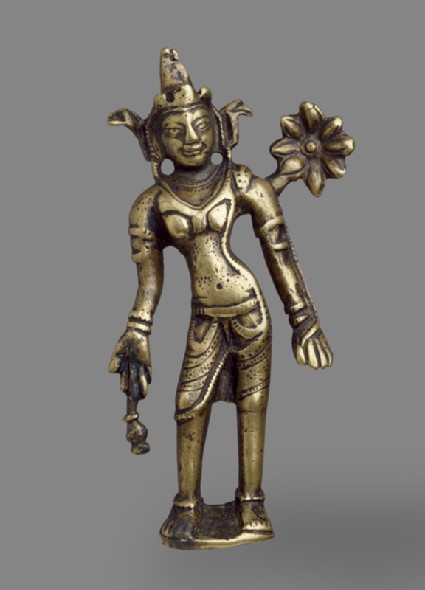Browse: 20 objects
- Reference URL
Actions
Figure of Avalokiteshvara
-
Details
- Associated place
-
Asia › Tibet › west Tibet (place of creation)
- Date
- 11th - 12th century (1001 - 1200)
- Material and technique
- brass, with traces of red pigment
- Dimensions
- 8.7 x 4.5 x 1 cm max. (height x width x depth)
- Material index
-
processed material › metal › alloy › copper alloy › brass
- Technique index
- Object type index
- No. of items
- 1
- Credit line
- Purchased, 1995.
- Accession no.
- EA1995.154
-
Further reading
Heller, Amy, Early Himalayan Art (Oxford: Ashmolean Museum, 2008), no. 38 on p. 118, p. 126, illus. p. 119
Location
-
- currently in research collection
Objects are sometimes moved to a different location. Our object location data is usually updated on a monthly basis. Contact the Jameel Study Centre if you are planning to visit the museum to see a particular object on display, or would like to arrange an appointment to see an object in our reserve collections.
Publications online
-

Early Himalayan Art
This slender standing Bodhisattva holds a large eight petal lotus flower and a small vase, representing the container of amrita, the nectar of immortality. This iconography was popular in Nepal, where it is known as Amoghapasa, but in this case he also holds a rosary, which apparently was not the intention of the sculptor here. In Tibetan or western Himalayan painting and sculpture, Avalokitesvara frequently serves as one of two standing attendant Bodhisattvas flanking the Buddha Sakyamuni [1]. The identification of this figure as an aspect of Avalokitesvara is indicated by the triangular object visible on the left shoulder, which must be understood as the head of an antelope, whose paws are decoratively tied over Avalokitesvara's heart.
Although the three-pointed crown is now broken, the tall chignon is visually balanced by the strong curves of the lateral ribbons of the crown. The face with its broad smile and wide eyes has much charm. A similar chignon and facial features, as well as the over-large fingers and toes, are found in a Manjusri now in the British Museum. Snellgrove identified this as a circa tenth-century sculpture originating in northwest India, while Klimburg-Salter has attributed it to the western Himalayas, eleventh to twelfth century [2]. Similar features are seen in a Manjusri in the Ford collection, attributed by Woodward to Western Tibet or the western Himalayas, 1000-1200 [3].
A small, light sculpture such as this might have formed part of a triad, or possibly have been placed among the consecration contents of a larger image of the Buddha Sakyamuni or a lama, since several similar images, including the British Museum Manjusri, were found inside a sculpture of a lama. These images share certain distinctive characteristics with this Avalokitesvara: very straight legs, a somewhat exaggerated bend at the hips, and a slight disproportion, as in the very large hands of this figure [4].
The beaded meditation belt appears to be an inlay in a different alloy, possibly with an admixture of silver due to the contrast in colour. Beside the lips there are traces of red pigment. The dhoti has diagonal stripes, alternating beading and a geometric pattern, but is only decorated at the front of the image. The back is unfinished from head to toes, except for a lug behind the lotus, indicating that it formerly had a prabha as well as a pedestal. Von Schroeder has identified several similar triads as Western Tibetan, eleventh to twelfth century, while Reedy has analysed the metal of similar sculptures found in triads as conforming with western Tibetan alloys [5]. Although these factors do indicate a western Tibetan provenance of the eleventh to twelfth century, comparison with the extant remains in the monasteries of the region, whether of clay sculptures or large cast standing Bodhisattvas, tends to suggest that these small cast images are the products of provincial ateliers in the western Himalayas or western Tibet which cannot yet be precisely identified.
[Footnotes:]
1 See von Schroeder, Indo-Tibetan Bronzes, pl. 32 etc., for several small triads of these Bodhisattvas.
2 Snellgrove, Indo-Tibetan Buddhism, pl. 17a, and Klimburg-Salter, The Silk Road and the Diamond Path, pl. 90: British Museum acc. no. 1905.5.19.15.
3 H. Woodward, 'Artistic production, religious practice' in Pal, Desire and Devotion, pl. 167, h. 14.9 cm.
4 See also Pal, Art of Tibet, pl. S8, who suggested a provenance from a remote provincial atelier.
5 Reedy, Himalayan Sculpture, pl. W119, for the Buddhist triad in the Pal collection, and W145, for the Los Angeles County Museum sculpture discussed by Pal (Art of Tibet, pl. S8).
© 2013 University of Oxford - Ashmolean Museum


